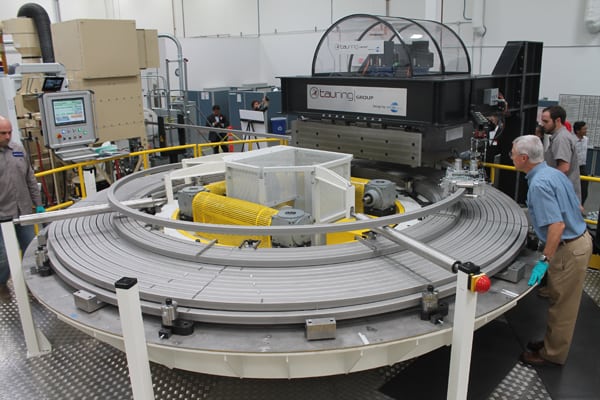Fabrication Begins for ITER Fusion Reactor Central Solenoid
Workers at San Diego's General Atomics (GA) on April 10 began the years-long process of winding the 1000-ton superconducting electromagnet that will power the ITER fusion reactor under construction in Southern France.
The $16 billion ITER project, a consortium of the U.S., the European Union, Russia, China, Japan, and other nations, aims to test reactor-scale nuclear fusion using plasma contained within a magnetic field. ITER has been under development for nearly a decade and will be the largest tokomak (toroidal magnetic chamber) ever constructed. The ultimate goal, once the facility is online in the 2020s, is to produce net power from fusion for the first time-up to 10 times the energy required to generate the magnetic field.
The central solenoid, being manufactured in a specialized facility built by GA for the project, will form the heart of the tokomak. It will be composed of more than four miles of superconducting cables wound into six individual modules and will stand nearly 60 feet tall (Figure 1). As John Parmentola, GA's senior vice president, explained, the cables are composed of copper, niobium, and tin components within a steel jacket, but because the superconductor material is brittle, it must be created by heating the modules after winding.
 1. Workers at General Atomics in San Diego begin the process of winding the superconducting modules that will form the central solenoid of the ITER fusion reactor. Source: POWER/Tom Overton
1. Workers at General Atomics in San Diego begin the process of winding the superconducting modules that will form the central solenoid of the ITER fusion reactor. Source: POWER/Tom OvertonThe wound modules will be placed inside a large oven, where they will be baked at 650C over a five-week process, with the heat converting the cable interior into a superconducting niobium-tin ceramic. After the winding and heating processes, the cable will be wrapped with fiberglass insulating tape and fused together with resin to create a single solid module (Figure 2).
 2. This sample cross-section of the solenoid cables shows the steel jacket surrounding the superconducting material. The tube in the center carries the supercritical helium used for cooling. Source: POWER/Tom Overton
2. This sample cross-section of the solenoid cables shows the steel jacket surrounding the superconducting material. The tube in the center carries the supercritical helium used for cooling. Source: POWER/Tom OvertonEach module, composed of 3,000 feet of cable, will take two years to complete. GA expects the seven modules it is manufacturing (one is a spare) to be completed by 2019. They will then be shipped to Texas for transport across the Atlantic to the ITER site in Saint Paul-lez-Durance, France. The individual components of ITER, including the solenoid modules, are so large and heavy that specialized transport vehicles had to be produced and the French government spent a110 million to upgrade the roads and bridges leading to the site.
When operating, the central solenoid will achieve a peak field strength of 13.1 Teslas and store enough energy to lift a Nimitz-class aircraft carrier. The field will contain plasma heated to more than 200 million degrees Celsius, where the fusion reactions will take place. ITER will initially use hydrogen in the plasma, later transitioning to deuterium, and ultimately, a deuterium-tritium mixture.
Ned Sauthoff, director of the U.S. ITER Project Office, said power density is what sets fusion apart from all other generation resources. "There's a factor of 20 million between the amount of energy you get per pound of fuel from fusion relative to chemical processes." If fusion can be made economic, he said, "It would really change the world."
The ITER group is officially shooting for first plasma by 2020, but Sauthoff told POWER he thinks 2025 is a more realistic date.
The ITER project will test a wide variety of heating, control, diagnostics, and remote maintenance technologies that would be required for use of fusion for power generation. If successful, ITER could lay the groundwork for commercial fusion reactor plants that could be online by the 2040s.
"It's not a matter of 'Does it work?'" Parmendola said. "What we have to figure out is how to make it work here."
-Thomas W. Overton, JD is a POWER associate editor (@thomas_overton, @POWERmagazine)
The post Fabrication Begins for ITER Fusion Reactor Central Solenoid appeared first on POWER Magazine.